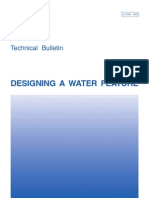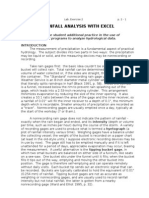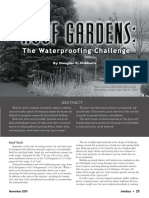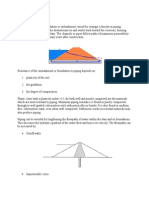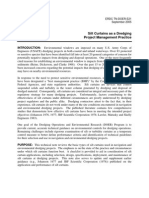Silt Curtain Effectiveness
Silt Curtain Effectiveness
Uploaded by
WellfroCopyright:
Available Formats
Silt Curtain Effectiveness
Silt Curtain Effectiveness
Uploaded by
WellfroOriginal Description:
Copyright
Available Formats
Share this document
Did you find this document useful?
Is this content inappropriate?
Copyright:
Available Formats
Silt Curtain Effectiveness
Silt Curtain Effectiveness
Uploaded by
WellfroCopyright:
Available Formats
Silt Curtains
Effectiveness
Technical
Note
Silt curtains are an extremely effective solution in controlling dispersed suspended sediments – when
specified and installed correctly.
The image above demonstrates a successful silt curtain deployment in the Middle East, where dredging operations
required the use of settlement ponds for the dredged slurry. This project is a good case study to demonstrate the
effectiveness of a correctly specified and installed marine protection barrier.
The double layer silt curtains (identified by the arrow in the picture) form a barrier between the outflow from the
settlement ponds and the open ocean. At the time the image was captured, extremely turbid water was flowing
beyond the settlement area, through the outflow and into an enclosed area where the silt curtains form the last line
of defense. These silt curtains were originally installed in mid-2017 as a “back-up” only. Two previous silt curtain
installations – one within the settlement area and one in the ocean – were installed as the first line of protection. They
have however since perished as they were not suitable for the environmental conditions or project purpose. As a
result, the correctly specified “back-up” double layer of silt curtains has become the new “first line of protection”, as
can be seen in the image. They are performing effectively, despite being under extreme pressure as the sole line of
protection remaining.
What are the critical factors to consider when selecting and installing a silt curtain for maximum
effectiveness? Firstly, it is important the correct silt curtain model is selected to withstand the hydrodynamics and
associated forces from varying environmental conditions, as the barrier will be exposed to numerous loads from tides,
currents and wave actions. Not all silt curtains are created equal and there are many models on the market that use
inferior materials and designs. In exposed conditions as with the above project, forces are significant and demand a
heavy-duty silt curtain. Material strength is critical and must always be paramount in the selection of the silt curtain.
Ecocoast • TEL +971 4 885 3944 • WEB www.ecocoast.com • EMAIL info@ecocoast.com
Silt Curtains
Effectiveness
Technical
Note
With increased water depth and respective deeper curtains comes a significant increase in the forces. For this reason,
it is seldom practical to extend a silt curtain beyond 4-5 meters. Excessive loads can lead to curtain failure or
anchoring system failure when not specified correctly. Furthermore, improper anchoring can lead to movement of the
barriers and an altered configuration, which in turn places additional loads on individual connections and subsequently
increases the probability of failure.
Silt curtains are designed to act as a settlement pond by allowing silts to settle from the upper portion of the water,
not to contain the water completely. Water should be allowed to flow under the silt curtain and a minimum gap of .5
meters should be maintained. As can be seen in the image, some silt will migrate, however, the area of spread is
limited. If the curtain sits on the seabed, sediment can build up over time dragging the curtain down and eventually
the floatation will be submerged. Where high levels of silt and sediment are present; as with the attached reclamation
project, the risk is increased.
Correct positioning of the silt curtains is also critical. They should ideally be placed a minimum of 50m from any
discharge. This provides a sufficient area and volume for settlement of the silt, reducing the risk of submersion through
the build-up of silts at the base of the silt curtain. Maintaining a reasonable distance also limits the flow velocity of
silts travelling directly from the discharge point, which not only reduces the force on the curtain and the potential of
vertical lifting, but also limits the amount of re-suspended silt taken from the seabed underneath the curtain.
This is often overlooked, yet it has played a crucial role in the above successful deployment and the integrity of the
silt curtains over the last 18-month period. In adverse weather conditions, the silt curtains should always be protected
and closely monitored. If removal and relocation is not possible, the curtain should be furled up to reduce impact and
loads. In addition, a maintenance schedule should include the repositioning of anchoring; maintaining an equal
distribution of loads and the replacement of any damaged connections, limiting the risk of failure.
A correctly specified, installed and maintained silt curtain system is extremely effective in the control of suspended
sediments, and in turn, limits the impact on the local environment.
Ecocoast • TEL +971 4 885 3944 • WEB www.ecocoast.com • EMAIL info@ecocoast.com
You might also like
- Earth EmbankmentDocument26 pagesEarth EmbankmentPutri ArumsariNo ratings yet
- Expansive SoilDocument4 pagesExpansive SoilIsaac Mureithi MainaNo ratings yet
- Designing A Water Feature - Tech BulletinDocument24 pagesDesigning A Water Feature - Tech BulletinLee BrazierNo ratings yet
- 2 - Rainfall Analysis2 - Rainfall Analysis With Excel - Doc With ExcelDocument6 pages2 - Rainfall Analysis2 - Rainfall Analysis With Excel - Doc With ExcelAbu Zafor100% (1)
- Construction MethodsDocument9 pagesConstruction MethodsScribdTranslationsNo ratings yet
- IOWA SUDAS-Silt Curtain Design ConsiderationDocument3 pagesIOWA SUDAS-Silt Curtain Design Considerationqwenc100% (1)
- Conception and Construction On Earth and Roskfill DamsDocument36 pagesConception and Construction On Earth and Roskfill DamsKatja BelakNo ratings yet
- V1 Chap4 6 Sediment Control FBDocument10 pagesV1 Chap4 6 Sediment Control FBMohamed ElfawalNo ratings yet
- Problem SiltationDocument4 pagesProblem SiltationKevinNo ratings yet
- Sub-Aerial Tailings Deposition: R.B. Knight, J.P. HaileDocument13 pagesSub-Aerial Tailings Deposition: R.B. Knight, J.P. HailejbautistavNo ratings yet
- Geosynthetics - An Innovative Solution For Hydraulics & Marine EngineeringDocument5 pagesGeosynthetics - An Innovative Solution For Hydraulics & Marine EngineeringJai Singh RathorNo ratings yet
- Roof Garden Drainage and IrrigationDocument6 pagesRoof Garden Drainage and IrrigationozianyayhradNo ratings yet
- Breakwater: Are Structures ThatDocument5 pagesBreakwater: Are Structures ThatporkopyoNo ratings yet
- Constructability - Unit 3Document6 pagesConstructability - Unit 3Shameem BmNo ratings yet
- Erosion Control BMPs Silt FencingDocument5 pagesErosion Control BMPs Silt FencingCORALationsNo ratings yet
- Dams Part2Document21 pagesDams Part2Hakim ANo ratings yet
- Waterproofing Problems: A Simple Explanation, A Simple SolutionDocument5 pagesWaterproofing Problems: A Simple Explanation, A Simple Solutionwaterproofing_bestNo ratings yet
- Hoofdstuk 5Document19 pagesHoofdstuk 5Axel RaesNo ratings yet
- By Douglas C. Fishburn: Roof DeckDocument4 pagesBy Douglas C. Fishburn: Roof DeckalperkarabulutNo ratings yet
- Breakwater: Are Structures ThatDocument5 pagesBreakwater: Are Structures ThatporkopyoNo ratings yet
- Breakwater: Are Structures ThatDocument5 pagesBreakwater: Are Structures ThatporkopyoNo ratings yet
- Embankment Dam EngineeringDocument42 pagesEmbankment Dam EngineeringMussaNo ratings yet
- River Protection Design GuideDocument13 pagesRiver Protection Design GuideEm MarNo ratings yet
- GeologyDocument3 pagesGeologyChristine Joy ConsolacionNo ratings yet
- Concrete MatressDocument6 pagesConcrete MatressNurul JannatiNo ratings yet
- L25 Waterproofing of Walls, Beams, Columns, Slabs, Retaining Walls PDFDocument43 pagesL25 Waterproofing of Walls, Beams, Columns, Slabs, Retaining Walls PDFarancyppNo ratings yet
- Roof Drainage DesignDocument2 pagesRoof Drainage DesignintequabNo ratings yet
- Principles of Design of RockfilldamsDocument20 pagesPrinciples of Design of Rockfilldamsumairfarooq2No ratings yet
- HakdogDocument19 pagesHakdogLei Yunice NorberteNo ratings yet
- MembraneDocument17 pagesMembraneNikhilAsudaniNo ratings yet
- Technical Considerations For The Design and Construction of Mine Seals To Withstand Hydraulic Heads in Underground MinesDocument9 pagesTechnical Considerations For The Design and Construction of Mine Seals To Withstand Hydraulic Heads in Underground Minesc.wolkeNo ratings yet
- Dam Safety Upstream Slope ProtectionDocument2 pagesDam Safety Upstream Slope ProtectionKunalini RatnavelNo ratings yet
- 2008-Prefabricated Vertical Drain - The Squeeze Is On-Wick Drain (PVD)Document3 pages2008-Prefabricated Vertical Drain - The Squeeze Is On-Wick Drain (PVD)Tato Del AguilaNo ratings yet
- Best Management Practices For The Maintenance and Operation of DamsDocument4 pagesBest Management Practices For The Maintenance and Operation of DamsikaspuspasariNo ratings yet
- Piping Embankment DamDocument5 pagesPiping Embankment DamNathan TaylorNo ratings yet
- Dam Embankment Construction 1723676941Document14 pagesDam Embankment Construction 1723676941Rasyid IrnazidinNo ratings yet
- CofferdamDocument5 pagesCofferdamviky100% (1)
- Introduction To Dams (FCE 511)Document43 pagesIntroduction To Dams (FCE 511)Mwengei MutetiNo ratings yet
- Geosynthetics in Coastal Engineering Protection and Placement IssuesDocument15 pagesGeosynthetics in Coastal Engineering Protection and Placement Issues蓉蓉No ratings yet
- Masonry Failures: Neil R. Baer, P.EDocument8 pagesMasonry Failures: Neil R. Baer, P.EVenkatesh ArunaNo ratings yet
- Flexible Slope Stabilization in Cowichan Bay, BC - Using A High-Tensile Steel Mesh To Stabilize A Steep Eroding Soil SlopeDocument7 pagesFlexible Slope Stabilization in Cowichan Bay, BC - Using A High-Tensile Steel Mesh To Stabilize A Steep Eroding Soil Slopemarineparade1407No ratings yet
- Silt Curtains As A Dredging Project Management PracticeDocument18 pagesSilt Curtains As A Dredging Project Management PracticeSeaworks Company100% (1)
- Chapter 15Document12 pagesChapter 15Aziz Khan Kakar100% (1)
- Coffer Dams ReportDocument20 pagesCoffer Dams ReportSubbaReddyNo ratings yet
- Feasibility Study - Terraforce PDFDocument4 pagesFeasibility Study - Terraforce PDFjunaid112No ratings yet
- Building Moisture Fixes Beyond DehumidificationDocument5 pagesBuilding Moisture Fixes Beyond Dehumidificationapi-250488572No ratings yet
- Waterproofing Techniques For Bored Tunnels: Crystalline SystemsDocument4 pagesWaterproofing Techniques For Bored Tunnels: Crystalline Systemskulbrsingh4975No ratings yet
- Geomembrane Liners in Wastewater Treatment Ponds Whales and Their PreventionDocument5 pagesGeomembrane Liners in Wastewater Treatment Ponds Whales and Their PreventionDimas NugrahaNo ratings yet
- ACI 347.2R-05 Guide For Shoring-Reshoring of Concrete Multistory Buildings - MyCivil - IrDocument21 pagesACI 347.2R-05 Guide For Shoring-Reshoring of Concrete Multistory Buildings - MyCivil - IrManimaran P100% (1)
- 3.1 Pre-Treatment (Gross Pollutant Retention)Document4 pages3.1 Pre-Treatment (Gross Pollutant Retention)Vinod SewlaniNo ratings yet
- Rubber DamDocument2 pagesRubber DamKhadim ShahNo ratings yet
- Waterproofing of Reinforced Concrete Flat Roof PDFDocument6 pagesWaterproofing of Reinforced Concrete Flat Roof PDFJimmy TanNo ratings yet
- Substructure Waterproofing ApplicationsDocument9 pagesSubstructure Waterproofing ApplicationsDXBBOOKSNo ratings yet
- Main ProposalDocument12 pagesMain ProposalAbhay SuwalNo ratings yet
- Waterproofing and Drainage - Building Substructures Enclose Basements, Parking Garages, or Other Usable Space - Engineering and Construction PDFDocument7 pagesWaterproofing and Drainage - Building Substructures Enclose Basements, Parking Garages, or Other Usable Space - Engineering and Construction PDFCiprian CipryNo ratings yet
- Gabion StoneDocument1 pageGabion StoneJoe EngelbrechtNo ratings yet
- Sewage Disposal Works: Their Design and ConstructionFrom EverandSewage Disposal Works: Their Design and ConstructionNo ratings yet
- Jones Etal2015Document26 pagesJones Etal2015WellfroNo ratings yet
- Control of Resuspended Sediments in Dredging ProjectsDocument12 pagesControl of Resuspended Sediments in Dredging ProjectsWellfroNo ratings yet
- Dubai Creek From Commercial Dock To StraDocument4 pagesDubai Creek From Commercial Dock To StraWellfroNo ratings yet
- Artificial Lighting at Night in Estuaries PDFDocument22 pagesArtificial Lighting at Night in Estuaries PDFWellfroNo ratings yet
- Project Description and MethodologyDocument14 pagesProject Description and MethodologyWellfroNo ratings yet
- GCC Statistical Center (2016)Document8 pagesGCC Statistical Center (2016)WellfroNo ratings yet
- Silt Curtain Selection GuideDocument6 pagesSilt Curtain Selection GuideWellfro100% (1)
- Edible Oils Processing 2014 ENDocument23 pagesEdible Oils Processing 2014 ENWellfroNo ratings yet
- ProjectClosureReport-v1 0Document83 pagesProjectClosureReport-v1 0WellfroNo ratings yet
- Law of AntiquitiesDocument9 pagesLaw of AntiquitiesWellfroNo ratings yet
- Stakeholder Analysis ToolDocument8 pagesStakeholder Analysis ToolRichard Thodé JrNo ratings yet
- San Francisco-Oakland Bay Bridge East Span Seismic Safety ProjectDocument18 pagesSan Francisco-Oakland Bay Bridge East Span Seismic Safety ProjectWellfroNo ratings yet
- Ozone Depleting SubstancesDocument7 pagesOzone Depleting SubstancesWellfroNo ratings yet
- Climate Report Saudi Arabia 2017Document5 pagesClimate Report Saudi Arabia 2017WellfroNo ratings yet
- Stakeholder SeminarDocument80 pagesStakeholder SeminarWellfro100% (1)
- Marpol Suplement 2015Document48 pagesMarpol Suplement 2015CvitaCvitićNo ratings yet
- Risk Assessment Example - Mobile Offshore Unit (MOU) Relocation Operations PDFDocument18 pagesRisk Assessment Example - Mobile Offshore Unit (MOU) Relocation Operations PDFWellfro0% (1)
- Stormwater Erosion and Sedimentation Control Inspector's ManualDocument378 pagesStormwater Erosion and Sedimentation Control Inspector's Manualjboston123100% (1)
- 3554 - Module 5 B - Plumbing Code HandoutsDocument11 pages3554 - Module 5 B - Plumbing Code HandoutspankajsallhNo ratings yet
- Climate Change Act of 2009: Framework and EffectivenessDocument16 pagesClimate Change Act of 2009: Framework and Effectivenessjhoanna mariekar victoriano100% (1)
- Project Idea - Water Conservation and Rainwater Harvesting Program in RajasthanDocument2 pagesProject Idea - Water Conservation and Rainwater Harvesting Program in Rajasthanshivani guptaNo ratings yet
- Sse 112 Midterm Exam QuestionairreDocument12 pagesSse 112 Midterm Exam QuestionairreEmmanuel EstopaNo ratings yet
- Class 4 Environment Studies Sample Paper Term 1 Model 1Document2 pagesClass 4 Environment Studies Sample Paper Term 1 Model 1Sunaina RawatNo ratings yet
- Watershed ManagementDocument17 pagesWatershed ManagementRutwik PadalkarNo ratings yet
- 03wknm21 Week03 2021Document112 pages03wknm21 Week03 2021IevgenGurievNo ratings yet
- Ib Ess Summer Pack 2023: This Paper Is Your Summer HomeworkDocument39 pagesIb Ess Summer Pack 2023: This Paper Is Your Summer Homeworkhalit özbelliNo ratings yet
- WaterNet - Profile Limpopo BasinDocument63 pagesWaterNet - Profile Limpopo BasinCristian ViverosNo ratings yet
- 0460 w13 Ms 22 PDFDocument6 pages0460 w13 Ms 22 PDFLuciano Sánchez AramburuNo ratings yet
- Kashmir Weather - Google SearchDocument1 pageKashmir Weather - Google Search9loveloveloveloveNo ratings yet
- PGE112.Sea Floor SpreadingDocument15 pagesPGE112.Sea Floor SpreadingnayemNo ratings yet
- Case Study 8.0Document2 pagesCase Study 8.0number oneNo ratings yet
- AJ Herbertson Classification of Natural RegionsDocument7 pagesAJ Herbertson Classification of Natural Regionssatyam agrawalNo ratings yet
- Weather Emergencies: Warning Means That A Tornado Has Been Sighted and Confirmed in The Area. When ADocument3 pagesWeather Emergencies: Warning Means That A Tornado Has Been Sighted and Confirmed in The Area. When ASantos RexNo ratings yet
- Weather Upper IntDocument4 pagesWeather Upper Intbabz117No ratings yet
- RepetMat U13 Test Podst BDocument2 pagesRepetMat U13 Test Podst B4k6fjtxyr2No ratings yet
- Impacts of Climate Change On Biodiversity and Ecosystem ServicesDocument12 pagesImpacts of Climate Change On Biodiversity and Ecosystem ServicesBHAJAN KUMARNo ratings yet
- Apes - Introduction To The Worlds BiomesDocument5 pagesApes - Introduction To The Worlds Biomesapi-265083667No ratings yet
- Conversion of UTM Coordinates To Decimal DegreesDocument13 pagesConversion of UTM Coordinates To Decimal DegreesNaasruNo ratings yet
- Chapter 02 BD Studies & Economic DevelopmentDocument21 pagesChapter 02 BD Studies & Economic DevelopmentDurjoy HasanNo ratings yet
- GeographyDocument144 pagesGeographyshiintu100% (1)
- On Corals of AndamanDocument20 pagesOn Corals of AndamanRajesh NayakNo ratings yet
- Meteorology Lesson-1Document114 pagesMeteorology Lesson-1Arjun PasrichaNo ratings yet
- Anthropogenic Changes On Landforms PDFDocument8 pagesAnthropogenic Changes On Landforms PDFDarieNo ratings yet
- 3 Horizon DesignationDocument4 pages3 Horizon DesignationArjay BedanaNo ratings yet
- TextDocument2 pagesTextbljw1408No ratings yet


